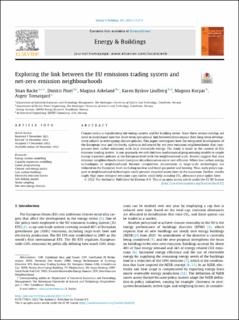| dc.contributor.author | Backe, Stian | |
| dc.contributor.author | Pinel, Dimitri Quentin Alexis | |
| dc.contributor.author | Askeland, Magnus | |
| dc.contributor.author | Lindberg, Karen Byskov | |
| dc.contributor.author | Korpås, Magnus | |
| dc.contributor.author | Tomasgard, Asgeir | |
| dc.date.accessioned | 2023-01-11T07:34:14Z | |
| dc.date.available | 2023-01-11T07:34:14Z | |
| dc.date.created | 2023-01-06T10:42:10Z | |
| dc.date.issued | 2023 | |
| dc.identifier.issn | 0378-7788 | |
| dc.identifier.uri | https://hdl.handle.net/11250/3042520 | |
| dc.description.abstract | Climate policy is transforming the energy system and the building sector. Since these sectors overlap, we need to understand how the short-term operational link between them impact their long-term development subject to overlapping climate policies. This paper investigates how the integrated development of the European heat and electricity system is influenced by net-zero emission neighbourhoods that compensate own carbon emissions with local renewable energy. The study is made in the context of EUs emission trading system. In our approach, we soft-link two mathematical programming models to couple energy transition policies at the European level with the neighbourhood scale. Results suggest that zero emission neighbourhoods make European decarbonisation more cost-efficient. When low carbon energy technologies in neighbourhoods become competitive, investments in large-scale technologies are reduced on the European level, including nuclear and fossil gas power and heating. Thus, early policy support to neighbourhood technologies could prevent stranded assets later in the transition. Further, results imply that more stringent emission caps earlier could help avoiding CO2 allowance price spikes later. | en_US |
| dc.language.iso | eng | en_US |
| dc.publisher | Elsevier | en_US |
| dc.rights | CC BY 4.0 | * |
| dc.rights.uri | http://creativecommons.org/licenses/by/4.0/ | * |
| dc.subject | Energy system modelling | en_US |
| dc.subject | Capacity expansion modelling | en_US |
| dc.subject | Linear programming | en_US |
| dc.subject | Climate and energy policy | en_US |
| dc.subject | Low-carbon buildings | en_US |
| dc.subject | Electricity emission factors | en_US |
| dc.subject | Soft-linking models | en_US |
| dc.subject | Sector coupling | en_US |
| dc.subject | Net-zero energy districts | en_US |
| dc.title | Exploring the link between the EU emissions trading system and net-zero emission neighbourhoods | en_US |
| dc.title.alternative | Exploring the link between the EU emissions trading system and net-zero emission neighbourhoods | en_US |
| dc.type | Peer reviewed | en_US |
| dc.type | Journal article | en_US |
| dc.description.version | publishedVersion | en_US |
| dc.rights.holder | © 2022 The authors | en_US |
| dc.subject.nsi | VDP::Teknologi: 500 | en_US |
| dc.source.volume | 281 | en_US |
| dc.source.journal | Energy and Buildings | en_US |
| dc.identifier.doi | 10.1016/j.enbuild.2022.112731 | |
| dc.identifier.cristin | 2101853 | |
| dc.relation.project | Norges forskningsråd: 257660 | en_US |
| dc.source.articlenumber | 112731 | en_US |
| cristin.ispublished | true | |
| cristin.fulltext | original | |
| cristin.qualitycode | 2 | |

